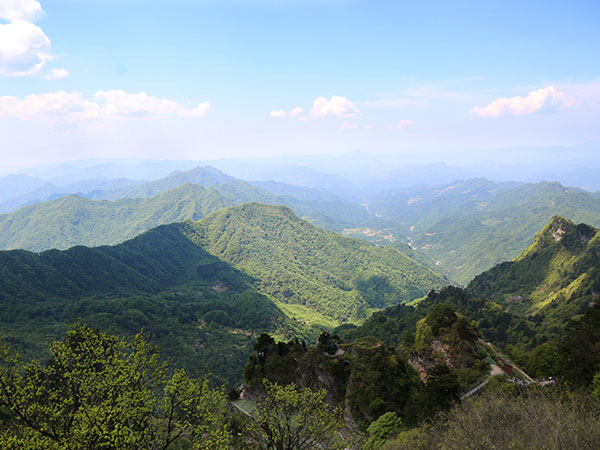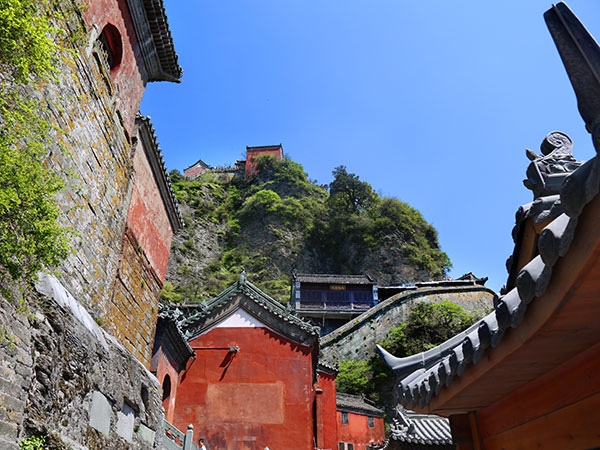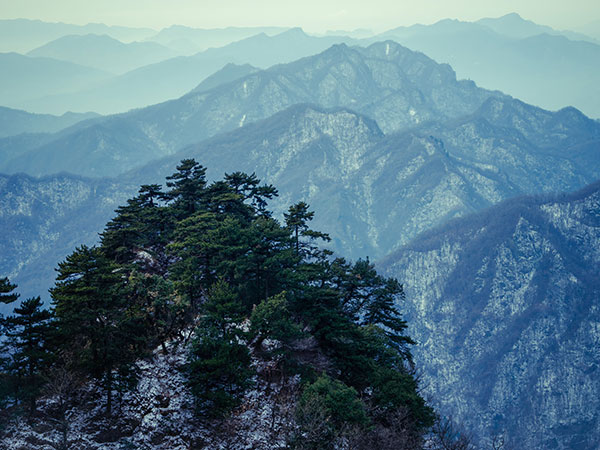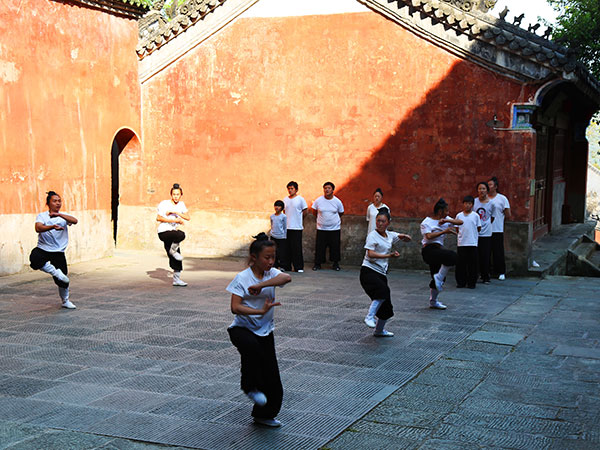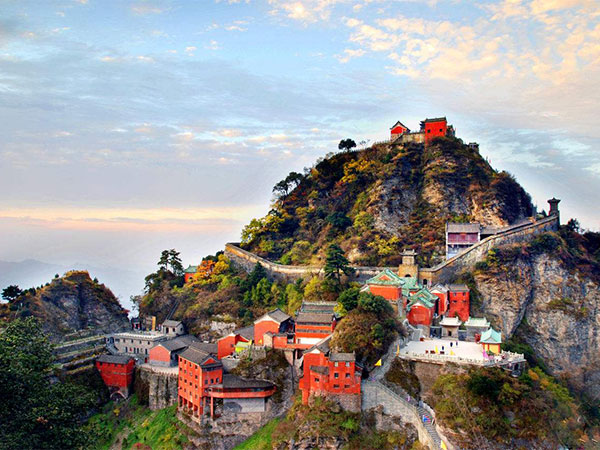Wudang Mountain, also called Taihe Mountain, is located in Shiyan City in the northwestern Hubei Province. China. Wudang Mountain may be the most famous Taoist holy site in China as well as in the world. The Ancient Building Complex in the Wudang Mountains has been on the World Heritage List since 1994 as a unique land to spread Chinese Taoist culture.
Mount Wudang covers an area of 321 square kilometers, with very rich beautiful sceneries and culture relics. The main tourist resorts include: three ponds, nine springs, nine wells, nine platforms, ten pools, ten stones, eleven caves, thirty six cliffs and seventy two peaks, all of them compose incomparable Chinese traditional mount-water drawings.
Ancient Building Complex in the Wudang Mountain
The ancient buildings in Wudang Mountain have been famous in the world for their beauty, size, and grandeur, so that Wudang Mountain was put into the list of World Cultural Legacy by UNESCO on December 17, 1994.
Most of the ancient buildings, devised and planed according to the legend of Zhenwu’s self-cultivation, assembled all the traditional building skills, and revealed that emperors’ rightful power and great and solemn Heaven. They also have shown that Taoism worships nature, to the extent of contributing great and beautiful royal palaces, mysterious and wonderful Taoism, quiet and classic gardens, and other features. The ancient buildings, the reflection of ancient scheme, plan and architecture, are also a wonder in the history of world buildings, especially the highly harmonious unity of artificial buildings and natural view-sites, gives reason to surprise all the people in the world.
Wudang Culture
The Wudang culture consists of Taoist philosophy and the facets of religious arts and crafts, such as music, martial arts, ritual customs, herbal medicine and much more. The cultural heritage sites, protected by the UNESCO, such as the imperial monasteries, palaces and temples, settled almost across the entire mountain area, form the essential foundation for the preservation of the Wudang culture.
Mt. Wudang is renowned as Immortals’ Mountain of Taoism and the World for Swordsman. It is a famous Taoist center in China with a long history of Taoist practice and a profound Taoist culture. It is also well-known for its deep-rooted tradition of wushu (martial arts). Typical examples of Wudang chuan are Taiji quan, Xing Yi Quan and Baguazhang. According to legend, Taijiquan was created by the Taoist hermit Zhang Sanfeng, who lived in the Wudang mountains.
Fun Things to Do in Wudang Mountain
Depending on your pursuits, there could be quite a lot of things to do and see in the area and you can easily enjoy your vacation and relax yourself for a couple of days.
【Enjoy the Beautiful Natural Scenary】
If your goal is to primarily do some sightseeing, you might find that one day would already be too much, especially when you take the cable car for up and down. Note that if you take the cable car up, there isn’t a lot of climbing left; an hour or at most two would be enough to see the whole area beyond the cable car station. The highest peak in this Wudang Mountain area is Tianzhu peak with an altitude of 1612 meters. The main historic sites to visit in the mountain area include Taihe Palace, Gutong Palace, Golden Hall, Jingle Palace, Yuxu Palace, Nanyan Temple, etc.
【Learn Chinese Wudang Kung Fu or Tai Chi】
There are a few Wudang Kung Fu or Tai Chi training halls at the academy in the mountain area where classes are also held. The academy also has a meditation hall for students. Also, some hotels on the mountain offer Kung Fu or Tai Chi training classes. It is usually charged by hours. If you are interested in learning Wudang Kung Fu or Tai Chi, you could sign up for one or two classes. Typical examples of Wudang Kung Fu are Tai Chi, Xing Yi Quan and Baguazhang. According to legend, Taijiquan was created by the Taoist hermit Zhang Sanfeng, who lived in the Wudang mountains. Every year, there are a large number of Chinese and foreign Wudang martial arts enthusiasts come here to learn Kung Fu or Tai Chi. They often practice Prince Slope on the mountain or Yuxu Palace at the foot of the hill.
In addition, you might find some Taoist martial arts enthusiasts who practice martial arts in the mountains area. You may quietly watch it in the side.
You’d better spend two days to visit Mount Wudang, in this way, you will be able to visit most main attractions in this mountain area.
Day 1: Entrance(山门)- Prince Slope(太子坡) – Purple Clouds Palace(紫霄宫)- Raven Hill(乌鸦岭_
Day 2: Raven Hill(乌鸦岭)- Nanyan Palace(南岩宫) – Golden Peak(金顶) – Qiongtai Platform(琼台) – YuXug Palace(玉虚宫)
You can hike or take a scenic tourist shuttle (included in the entrance fee), to reach main scenic attractions in the mountain. From Nanyan Palace to Golden Peak, it needs to hike. You may take Taihe Cable Car to travel between Golden Peak and Qiongtai Platform. Raven Hill is one of the main places for overnight stay.
Highlight Sites to Visit in Mount Wudang
Zixiao Temple: Zixiao Temple which means Purple Cloud Temple in Chinese is located on the Zhanqi Peak in Wudang Mount. Built in North Song Dynasty and renovated for about three times, Zixiao Temple is the largest scale well-preserved Taoism architecture in the world. There are 29 buildings with a building area of 6,854 square meters. Zixiao Temple is an apotheosis of construction by employing the particular physiognomy that is cragged in length while wide and plain on breadth. All the buildings are arrayed along the axis. On the axis lie the Green Dragon and White Tiger Palace, Imperial Stele Pavilion, Shifang Hall, the Grand Hall of Zixiao Temple and Parents’ Palace from the bottom to the top. The altitude of these building gradually rises and the axis symmetries the wing houses of each construction. And through the way of stacking tall sidesteps, the Zixiao Temple is divided into three sections of yard, so as to form a kind of group of constructions in which one row is upon row of the other and the primary buildings are more distinctive than the secondary ones. From a far distance, the palace has the airs of imperial worshipping rites.
Nanyan Temple: Nanyan Temple in Wudang Mount is listed as the national cultural relic as a famous Taoism palace. According to the related historic records, this temple was built in Yuan Dynasty, while it was destroyed in the end of Yuan Dynasty. Rebuilt in Ming Dynasty, there were more than 640 palaces. Nanyan which means south cliff may be one of the most beautiful cliffs in Wudang Mount. South Cliff is also called Duyangyan which means solitary sun cliff in China. It is the holy land for Taoist people to go to the heaven. Ancient people preferred to describe this place into one sentence “Morning bell and night lamp” to express the elaborate architectural style in this site. The temple is enshrined with gilded bronze statues of several dozen Taoist deities, including the God of Prime Origin and the North God. There are also 500 gilded iron statues of the heavenly officials on the cliffs, each about 30 cm tall. With their well-balanced proportions, they are amazingly life-like.
Golden Hall: Golden Hall in Wudang Mount is located on the Tianzhu Peak. Built in Ming Dynasty 1416, it was made of golden material in a wooden architectural style, thus its name Golden Hall. It is the symbol of Wudang Mountain. It represented the peak time and the high position of the Taoism in the ancient royal system. Standing in front of the Golden Hall, visitors can have a bird’s view of the Mount Wudang. The magnificent mountains are solid, while the worship scene and the holy atmosphere make this site as the most holy land in Mount Wudang. The Golden Hall was first cast part by part, which were then riveted and welded together. The connection was precise and integrated without any marks of cast or chisel. Despite of the natural erosion and thunder hits for over five hundred years, the palace is still goldenly splendid as if it was new and is regarded as a pearl in the history of ancient architecture and casting technology in China. The Golden Hall contains a bronze statue of Zhen Wu, another name for the Northern Emperor, Beidi (Cantonese Pak Tai), a popular Daoist deity. Around the statue stand more gilded copper statues. Between them, the statues and hall represent the best in Ming copper work.
How to Get There
Wudang Mountain is sited in Shiyan City in Hubei Province. Land transport to reach there is more convenient and developed, by rail or road. There is no civil airport in Mt.Wudang area, if you plan to travel by plane, you need to arrive by air in Xiangfan, Shiyan or Wuhan, then transfer to car to reach the Wudang Mountain.
【By air】: There is no direct flight to Mt.Wudang Scenic Area. But flights from some big cities such as Beijing, Guangzhou and Xian can reach to the Laohekou Airport (90km from Wudang Mount), Xiangfan Airport(180km from Wudang Mountain), and Wuhan Airport (500km from Wudang Mount). The nearest airport is in Shiyan, which is only 1 hour away, but officially the airport is also known as Wudangshan (“Shiyan Wudangshan Airport”). Flights from Wuhan, Guangzhou, Lanzhou, Shanghai are common.
【By bus】: No.316 national way and No.209 national way go through Wudang District. And people can get bus to Wudang Mount from Shiyan city, Danjiang city and Xiangfan city or Wuhan city .
【By train】: Xiangfan-Chengdu railway pass through the Wudang Scenic Area. And the near railway stations include: Wuhan Station and Shiyan Station. There are more than 40 trains to Wudang from many big cities such as Beijing, Shanghai, Guangzhou, Xiamen, etc. There is a direct train from Wuhan going to Shiyan.
Inside the park there is a superb shuttle bus transport system. You can get to all the major tourist spots by bus. The service is included in your national park ticket and you can use the buses from morning to evening as much as you like. Buses are very frequent and don’t let you wait very long. Sometimes they even depart with just two people inside.
Best Time to Visit to Wudang Mountain
March to May& September to early November, when is the spring and autumn time separately in this area. In spring, there is temple fair on March 3 of Chinese lunar calendar, which is quite a chance to experience the local culture. In autumn, when is Wudang International Tourism Festival, it is the best time to learn Wudang traditional culture. Wudang has a subtropical monsoon climate, with obvious vertical climate. The temperature decreases with a ring altitude. Climate of the whole mountain zones divided into 3 classes: in the top is from Chaoyang Palace to Jinding Temple, 1200-1600 meters above sea level; the annual average temperature is about 8.5℃; the middle is from Zixiao Temple to Chaoyang Palace, 750-1200 meters above sea level, the annual average temperature is 12℃; the bottom is Crown Prince Slope at an altitude of 750 meters below, the annual average temperature is about 15.9℃.
Travel Notes
• Be careful to visit the cultural relics and the plants in the scenic area.
• It is forbidden to take photos in the religious temple and palaces
• Smoking is forbidden in the scenic area
• Wearing comfortable shoes to climb the mountain
• Keep drinking enough water and take rest in a fixed period
• The changeable temperature in the mountain area asks people to pay more attentions on cloth wearing. Be sure to carry a cold-proof cloth during your climbing time

